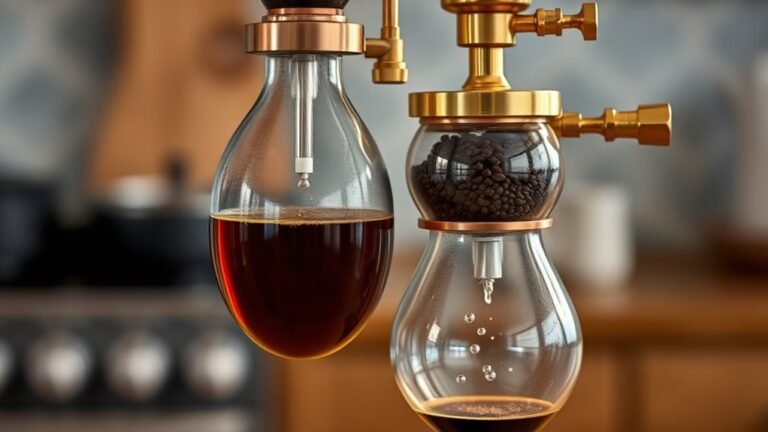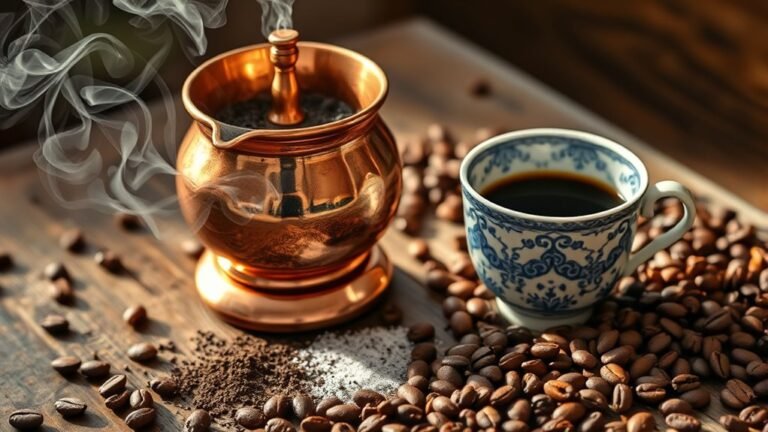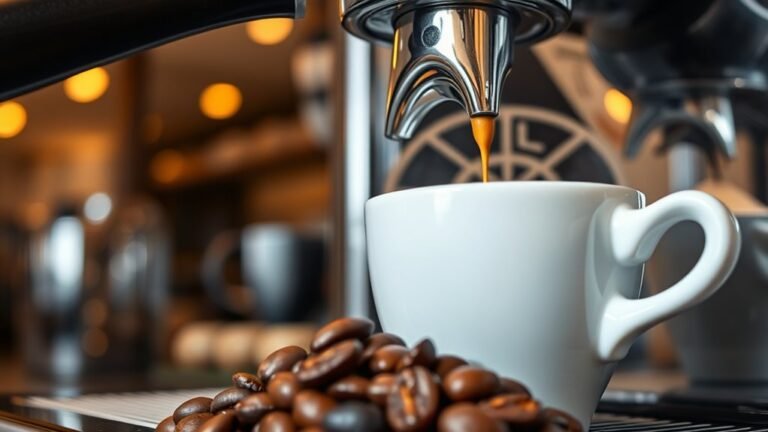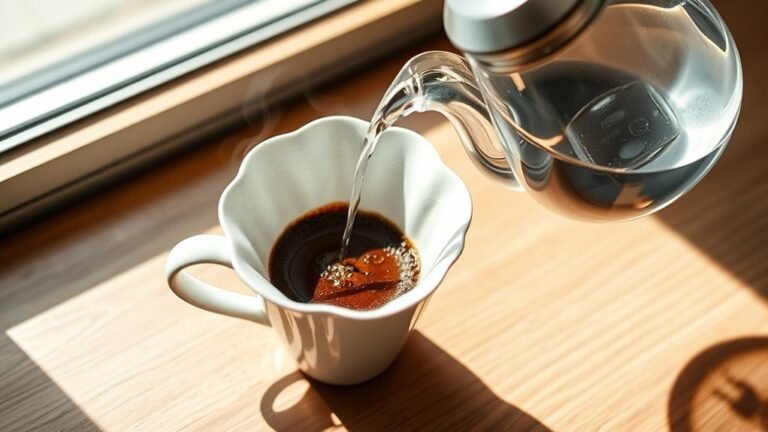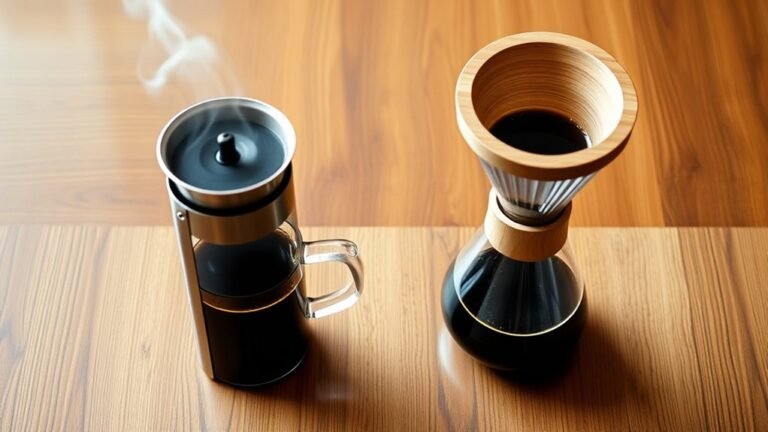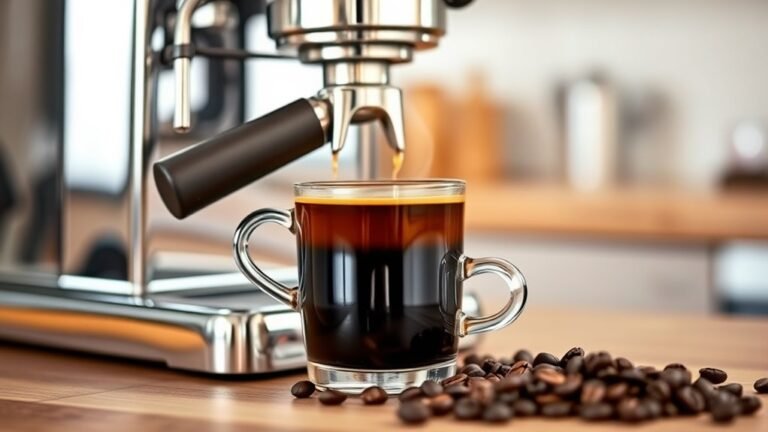The Science Behind the Perfect Coffee Extraction Time
You control perfect coffee extraction time by balancing grind size, water temperature, and brewing method to dissolve desirable flavor compounds without extracting excess bitterness or sour notes. Finer grinds and higher temperatures speed extraction but risk over-extraction, while coarser grinds and cooler water slow it, preserving delicate flavors yet risking under-extraction. Precise brewing and measurement help you avoid these extremes, optimizing flavor balance. Understanding these factors reveals deeper control over your coffee’s character and consistency.
Understanding Coffee Extraction
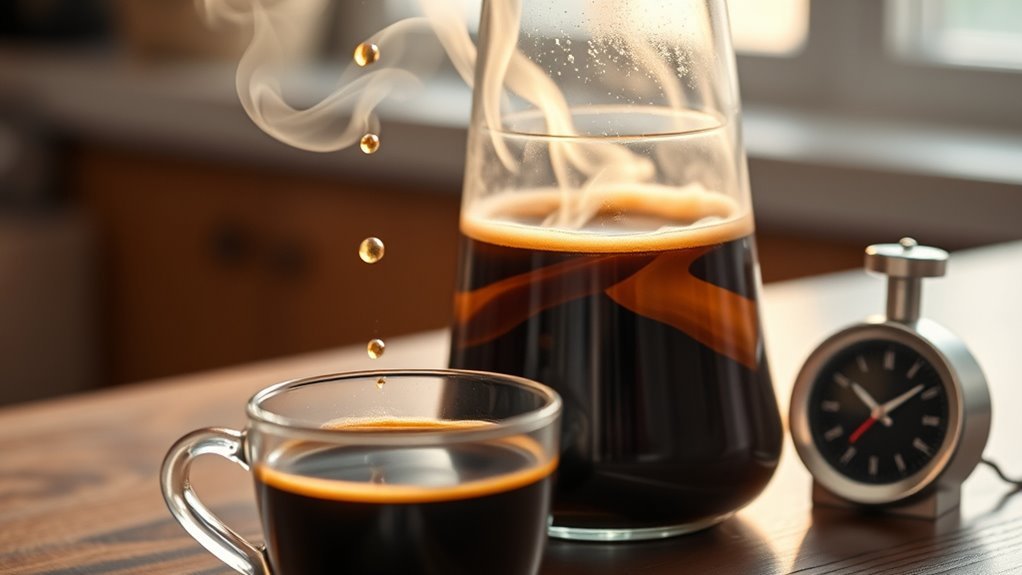
Extraction is the process where water dissolves soluble compounds from coffee grounds, determining the flavor and strength of your brew. To master this, you need to grasp coffee solubility—how different compounds dissolve at varying rates. Early extraction yields bright acids and sugars, while prolonged contact releases bitters and astringents. Your control over brewing variables like water temperature, grind size, and agitation directly influences solubility and extraction efficiency. Higher temperatures increase solubility but risk over-extraction if not timed right. Finer grinds expose more surface area, accelerating extraction but can cause bitterness if overdone. By precisely balancing these variables, you reveal the full flavor potential and enjoy the freedom to tailor your coffee’s character exactly how you want it. Understanding these dynamics is key to crafting your perfect cup.
Factors Affecting Extraction Time
While several elements influence how long it takes to brew your coffee, understanding these factors helps you control the extraction time with accuracy. Extraction time hinges on the delicate balance of coffee solubility and brewing chemistry, determining how compounds dissolve and interact during brewing. Temperature, water composition, and agitation greatly impact solubility rates and consequently the extraction.
| Factor | Impact on Extraction Time |
|---|---|
| Water Temperature | Higher temps increase solubility speed |
| Water Composition | Minerals affect compound dissolution |
| Agitation | Enhances contact, speeds extraction |
| Coffee Dose | More grounds require longer extraction |
The Role of Grind Size in Extraction
You’ll find that grind size directly influences how quickly water extracts flavors from coffee grounds, impacting both taste and extraction rate. A finer grind increases surface area, speeding up extraction but risking over-extraction if not controlled precisely. Consistency and uniformity in grind size are critical to achieving an even extraction and avoiding bitter or sour notes.
Impact on Flavor
Because grind size directly influences how water interacts with coffee grounds, it plays an essential role in determining your brew’s flavor profile. A finer grind increases surface area, allowing water to extract more aromatic compounds quickly, which can heighten brightness and acidity but risks bitterness if over-extracted. Conversely, a coarser grind slows extraction, preserving subtle flavors and reducing bitterness, but may lead to under-extraction, resulting in a flat or sour taste. Mastering grind size lets you control the balance of flavor profiles, revealing the coffee’s full spectrum from fruity and floral notes to rich, chocolatey undertones. By adjusting grind size thoughtfully, you gain freedom to tailor your brew, ensuring each cup delivers the precise aromatic complexity and flavor intensity you desire.
Extraction Rate Control
Grind size doesn’t just affect flavor; it directly governs the extraction rate—the speed at which water dissolves soluble compounds from the coffee grounds. When you adjust grind size, you’re controlling a critical extraction variable that influences contact surface area and flow resistance. A finer grind increases surface area, accelerating extraction but risking over-extraction if not balanced. Conversely, a coarser grind slows extraction, potentially causing under-extraction. Mastering this balance enables you to tailor brewing consistency across different methods and beans. By calibrating grind size precisely, you gain control over how quickly the water interacts with the coffee solids, ensuring that your extraction time hits the ideal window. This control is indispensable for freedom in dialing in your brew, allowing you to optimize flavor without sacrificing consistency.
Consistency and Uniformity
Although many factors influence coffee extraction, achieving consistency and uniformity in grind size is paramount to controlling flavor development. When your grind particles are uniform, water flows evenly through the coffee bed, promoting balanced extraction and avoiding over- or under-extracted pockets. Extraction consistency hinges on this uniformity importance, as varying particle sizes cause uneven extraction rates, leading to unpredictable flavors. By maintaining precise control over grind size, you guarantee that each particle contributes equally to the extraction process, allowing you to fine-tune brewing parameters confidently. This uniformity not only stabilizes extraction time but also enhances repeatability, granting you the freedom to experiment with recipes without the variable of inconsistent grind size clouding results. Ultimately, prioritizing extraction consistency through grind uniformity elevates your ability to craft coffee with clarity and precision.
Water Temperature and Its Impact
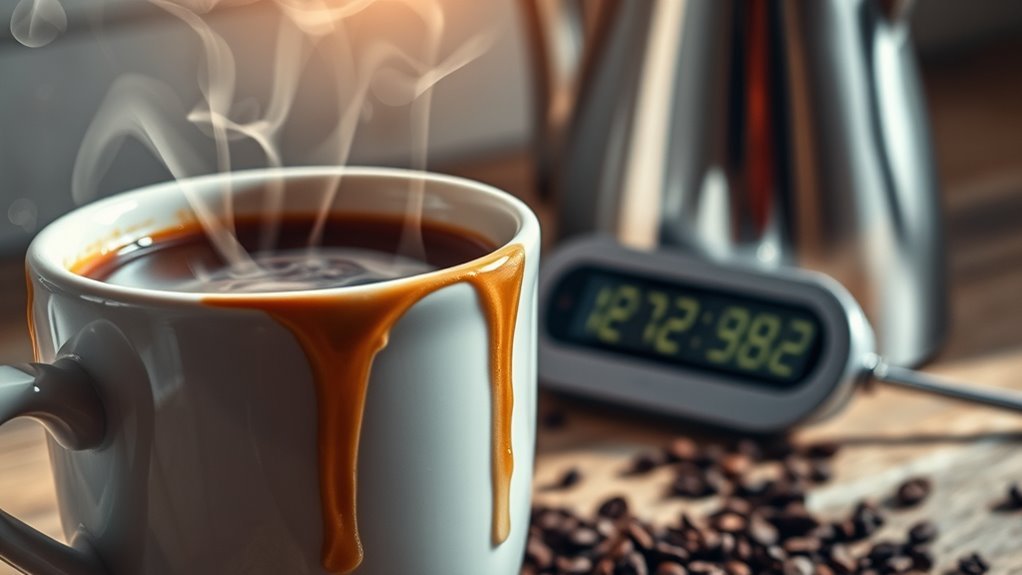
When you adjust the water temperature during coffee extraction, you directly influence the solubility of the coffee compounds, which affects flavor balance and extraction efficiency. Higher temperatures accelerate extraction, releasing oils and acids swiftly, but risk over-extraction, leading to bitterness. Lower temperatures slow the process, preserving delicate aromatics but may cause under-extraction and sourness. Mastering this balance grants you freedom to tailor your brew precisely.
Adjusting water temperature unlocks precise control over coffee flavor, balancing extraction speed and taste nuances.
Consider how water temperature impacts you:
- Reveals full flavor potential by optimizing compound solubility
- Empowers control over bitterness and acidity levels
- Enhances extraction efficiency, saving time without compromising quality
- Grants freedom to experiment and craft your unique coffee profile
Brewing Methods and Their Extraction Times
Since each brewing method applies water to coffee grounds differently, the ideal extraction time varies greatly, influencing the final taste and strength of your cup. For example, espresso demands a short extraction—around 25 to 30 seconds—with low brew ratios (1:2), producing intense, concentrated flavor profiles. In contrast, pour-over methods use longer extraction times, typically 2.5 to 4 minutes, paired with higher brew ratios (1:15 to 1:17), highlighting clarity and nuanced flavors. French press requires immersion for 4 to 5 minutes with similar brew ratios but yields a fuller-bodied profile due to extended contact time. Understanding these dynamics empowers you to tailor extraction times precisely, harnessing each brewing method’s unique interaction with coffee grounds and water to achieve your preferred flavor balance and strength.
Signs of Under-Extraction and Over-Extraction
Mastering extraction times is only part of achieving the perfect cup; recognizing how under-extraction and over-extraction affect flavor is equally important. Under extraction causes a sour, sharp taste and a thin body because essential oils and sugars haven’t fully dissolved. Over extraction effects include bitterness and a hollow, dry mouthfeel, as tannins and undesirable compounds leach out excessively. You’ll notice:
- Astringent, unpleasant acidity signaling under-extraction
- Flat, weak flavor profiles lacking sweetness
- Harsh bitterness and lingering aftertaste from over-extraction
- Dull, lifeless aroma stripping away coffee’s character
Tips for Achieving Optimal Extraction Time
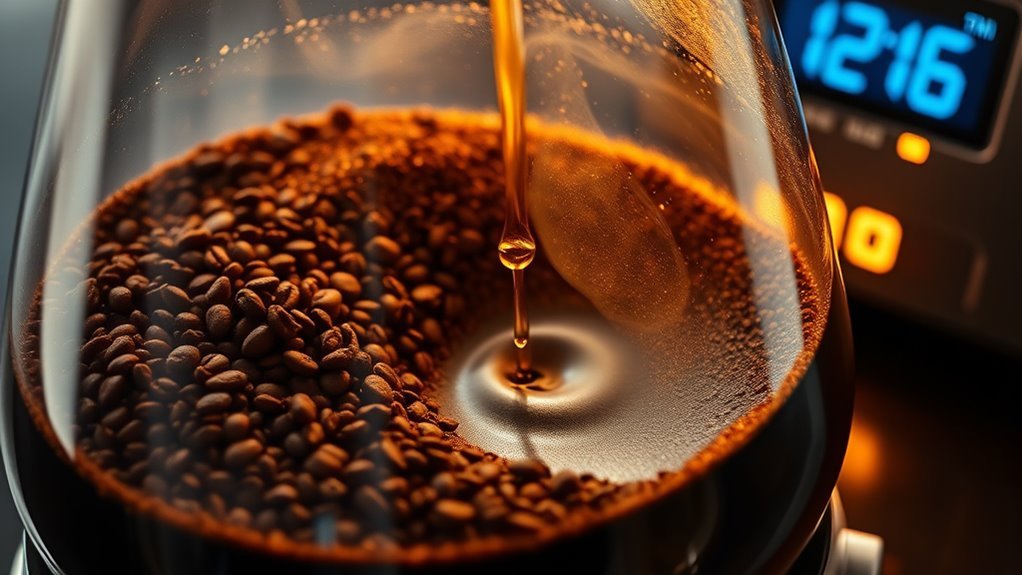
Although achieving the perfect extraction time demands attention to multiple variables, you can consistently refine your process by controlling grind size, water temperature, and brew duration with precision. Start by adjusting your grind size: finer grinds increase extraction speed, while coarser ones slow it down. Maintain water temperature between 195°F and 205°F to optimize solubility without burning the grounds. Monitor brew duration closely; slight changes can dramatically shift flavor profiles. Employ consistent brewing techniques—whether pour-over, espresso, or immersion—to guarantee repeatability. Use a timer and scale to measure inputs precisely, allowing you to isolate variables and understand their impact. By systematically tweaking these parameters, you gain freedom to craft coffee that highlights desired flavor profiles, avoiding under- or over-extraction pitfalls and achieving balance in every cup.
Frequently Asked Questions
How Does Coffee Bean Origin Affect Extraction Flavor Profiles?
Imagine tasting a vibrant sunrise captured in a cup—coffee’s origin characteristics shape those flavor nuances. When you brew, beans from Ethiopia might offer floral, citrusy notes, while those from Sumatra bring earthy, spicy tones. These origin traits influence how compounds extract, altering bitterness, acidity, and body. By understanding this, you can adjust brewing to highlight desired flavors, giving you the freedom to craft a cup that truly expresses the bean’s unique story.
What Is the Impact of Roast Level on Extraction Time?
You’ll notice that light roasts usually require a longer extraction time because their denser structure makes it harder for water to penetrate and dissolve flavors. Dark roasts, on the other hand, are more porous and brittle, so they extract faster. Adjusting your brewing time based on roast level helps you avoid under-extraction with light roasts and over-extraction with dark roasts, giving you greater freedom to dial in the perfect cup.
Can Water Mineral Content Alter Coffee Extraction?
You might think water mineral content has zero effect, but it can totally make or break your brew! Water hardness and mineral balance directly influence extraction by interacting with coffee solubles. Too much hardness can over-extract, causing bitterness, while too little leaves your cup flat. Adjusting mineral content lets you fine-tune flavor and extraction time, giving you freedom to craft the exact coffee experience you crave with precision and control.
How Does Altitude Influence Coffee Extraction Parameters?
Altitude effects greatly impact your coffee extraction parameters because water boils at lower temperatures as altitude increases. This means your brewing temperature drops, potentially under-extracting flavors. To counteract this, you’ll need to adjust your brewing techniques—like increasing brew time or grind size—to guarantee proper extraction. By understanding these altitude effects, you’ll have the freedom to fine-tune your process and consistently craft a balanced, flavorful cup regardless of elevation.
Are There Health Benefits Related to Extraction Time Variations?
You’ll find that extraction benefits extend beyond flavor; varying extraction time can influence the concentration of bioactive compounds like antioxidants. Shorter extractions might retain more caffeine and chlorogenic acids, which have potential health considerations, including enhanced alertness and antioxidant effects. Longer extractions could increase bitter compounds, possibly impacting digestion. By adjusting extraction time, you gain control over both taste and health-related properties, giving you freedom to tailor your brew to your wellness preferences.

